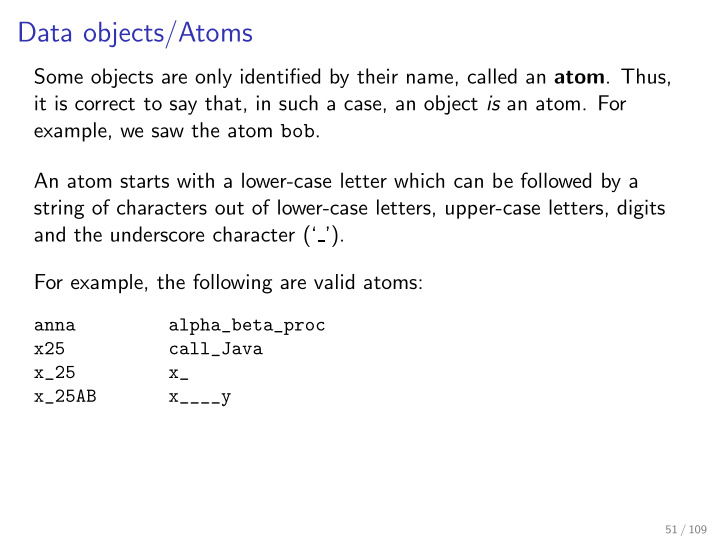



Data objects/Atoms Some objects are only identified by their name, called an atom . Thus, it is correct to say that, in such a case, an object is an atom. For example, we saw the atom bob . An atom starts with a lower-case letter which can be followed by a string of characters out of lower-case letters, upper-case letters, digits and the underscore character (‘ ’). For example, the following are valid atoms: anna alpha_beta_proc x25 call_Java x_25 x_ x_25AB x____y 51 / 109
Data objects/Numbers Numbers in Prolog include integer numbers and floating-point numbers. The syntax of integer is as expected, for example 1 1234 0 -97 The lower and larger integers are limited by the actual Prolog system in use. Floating-point numbers follow the usual syntax too, like 3.14 -0.06 100.5 The general syntax is not given here because Prolog is primarily intended for symbolic computations, not numerical computations. Atoms and numbers define the group of constants . 52 / 109
Data objects/Variables A variable is a name for an object, but, contrary to atoms, variables do not define any object. So a variable can denote several objects. They must start with an upper-case letter or an underscore and may be followed by any number of letters, digit and underscores, in any order. For example, the following are valid variables: X Obj_List _23 Object2 Result ObjList _x23 If a variable appears only once in the body of a clause and not in the head, it is an unknown variable and can be replaced by an underscore. For example has_a_child(X) :- parent(X,Y). can be replaced by the equivalent has_a_child(X) :- parent(X,_). 53 / 109
Data objects/Variables (cont) Several underscores can occur in a body. In this case, each of them should be considered an absolutely unique, despite unknown, variable. For example, consider someone_has_a_child :- parent(_,_). Each underscore could be replaced by a unique variable, like someone_has_a_child :- parent(X,Y). But certainly not someone_has_a_child :- parent(X,X). 54 / 109
Data objects/Variables and lexical scopes If an unknown variable appears in a query, then its value, found by the interpreter, is not displayed in the result. For example, if one wants to know who are the people who have children, the Prolog query is ?- parent(X,_). and only all the possible values of X that satisfy the query will be displayed. Given an occurrence of a variable, the part of the program where this variable is usable is called the scope . 55 / 109
Data objects/Variables and lexical scopes (cont) Prolog uses lexical scoping , which means • the same variable always represents the same object inside a clause; • the same variable in two different clauses represent different objects, in general. For example, in clause ancestor(X,Y) :- parent(X,Y) the tow occurrences of variable X represent the same object. But, if we also have ancestor(X,Y) :- parent(X,Z), ancestor(Z,Y). the occurrences of X denote, in general, objects different from the X in the previous clause. 56 / 109
Data objects/Functors and structures Structured objects, or structures , are objects that are composed of several objects. These sub-objects are boxed together by means of a functor . For example date(9,july,2006) is a structure composed, in order, of the integer constant 1 , the atom july , the number 2006 and tied together by the functor date . The sub-objects are called arguments and the number of arguments is the arity . The syntax of functor is the same as the atoms. Functors are used to define facts (i.e. instances of a relation). For example, female(pam). 57 / 109
Data objects/Functors and structures (cont) Just as it is possible to make a graphical representation of a successful run of the Prolog interpreter (see page 48), it is possible to draw a tree which represents a Prolog structure. The idea here is to map a functor to a node whose label is the functor, and its arguments to sub-trees, recursively in the same order. The consequence is that the component objects that are not structures are mapped to the leaves. For example add date 5 mult 9 july 2006 X 6.3 58 / 109
Data objects/Summary It is also handy to represent all the kinds of Prolog data objects we reviewed until now in a tree. The idea consists in mapping a set of lexical elements to a node whose label is this set name, and the subsets are mapped to subtrees. data objects simple objects structures constants variables atoms numbers integers floats 59 / 109
Recommend
More recommend